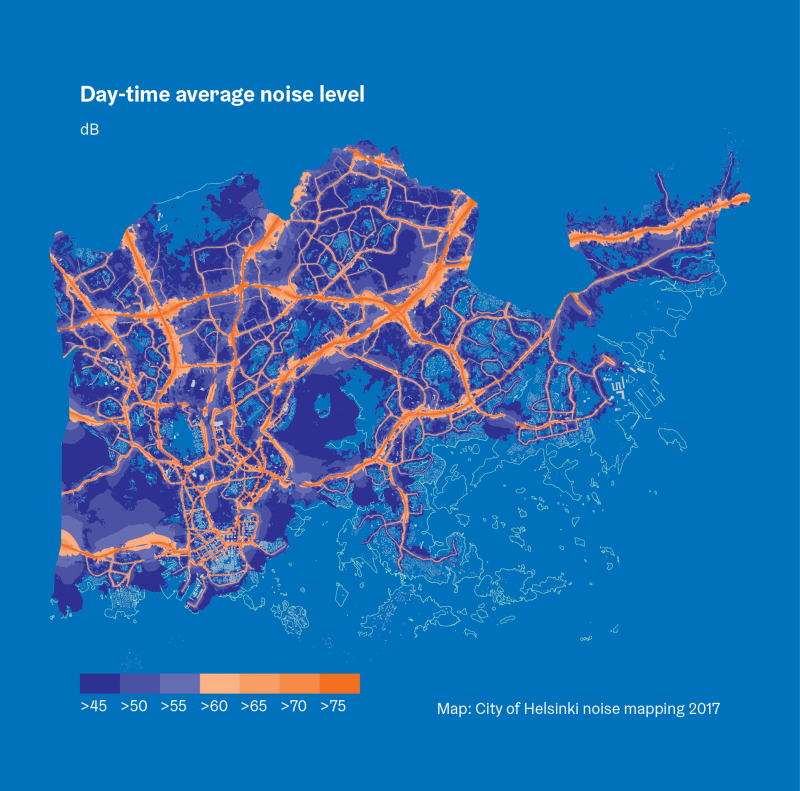Noise abatement
Environmental noise decreases the quality and comfort of the living environment in Helsinki. Continuous loud noise also causes health hazards. Road traffic is the primary source of harmful noise. 37% of the residents of Helsinki live in areas where the noise level caused by road traffic exceeds the limit value of 55 dB during the day. Noise is locally caused also, for example, by construction and repair works, public events and restaurants.
In accordance with the City Strategy, traffic investments and land use are always planned together in Helsinki, which makes it possible to pay attention to noise abatement. The noise abatement operations in the City of Helsinki are directed by the noise abatement plan 2018–2022. Land use and transport planning are also used to prevent harmful noise.

In addition to prevention, noise abatement actions are needed: these include noise-absorbing road surface materials, lower speed limits and reducing the use of studded tyres. The principles for defining speed limits were approved in 2018, and speed limits were lowered in several street locations in 2019. The use of speed cameras and speed screens has been increased in the City. In 2019, noise-absorbing road surface materials were used on the street section between Kontulantie and Kivikonkaari. HKL has started a general plan to improve the Herttoniemi metro noise barrier.
By improving the prerequisites of public transport, pedestrian traffic and cycling, the aim has been to steer traffic towards more sustainable forms of transport. The most significant change, redeveloping the section of Hämeentie between Siltasaarenkatu and Helsinginkatu into a pedestrian, cycling and public transport street, was started in the spring of 2019. The work will be completed in late 2020. Sustainable transport was also promoted by means such as the Kulkuri project of the City’s Environmental Services, the target group of which were children and their families.
The preparation of the noise reporting decisions regarding large outdoor concerts used end-time policies with which the disturbances experienced by the local residents by large and late music events could be diminished. The policies define maximum numbers allowed for late concerts. The policies concerned the venues in Kaivopuisto, Hietaniemi, Wholesale Market-Teurastamo, Suvilahti, Kyläsaari, Kaisaniemi, Töölönlahti Park, Mäntymäki Field, the Ice Hall parking area, Malmi Airport and Kansalaistori Square. Good prior provision of information has been shown to reduce the noise disturbance experienced by residents.
The City’s project to monitor the environmental hazards of construction continued in 2019 in regional construction sites in Keski-Pasila, Kalasatama, Jätkäsaari, Kruunuvuorenranta and Kuninkaantammi. Aspects such as noise were under intensified monitoring in these locations. At these sites, a lot of pile driving, excavation and crushing continued to be carried out, concerning which noise disturbance notifications were made. To prevent the construction site noise that will last for years from being unreasonable to the residents living in these areas, conducting the noisiest work in evenings or at weekends without a legitimate reason was not allowed.
Construction of the Jokeri Light Rail began in the summer of 2019. The work will last several years, and there is a great number of residents living by the track and being exposed to noise. The construction of the Jokeri Light Rail is primarily supervised by the Uusimaa Centre for Economic Development, Transport and the Environment. The harmful noise experienced by the residents has been successfully mitigated with efficient information provision, scheduling of the work and noise abatement procedures.
Eyes on the future:
In a densifying city, attention must be paid to noise abatement and the soundscape. Extensive infrastructure projects and local construction projects will continue for several years.
